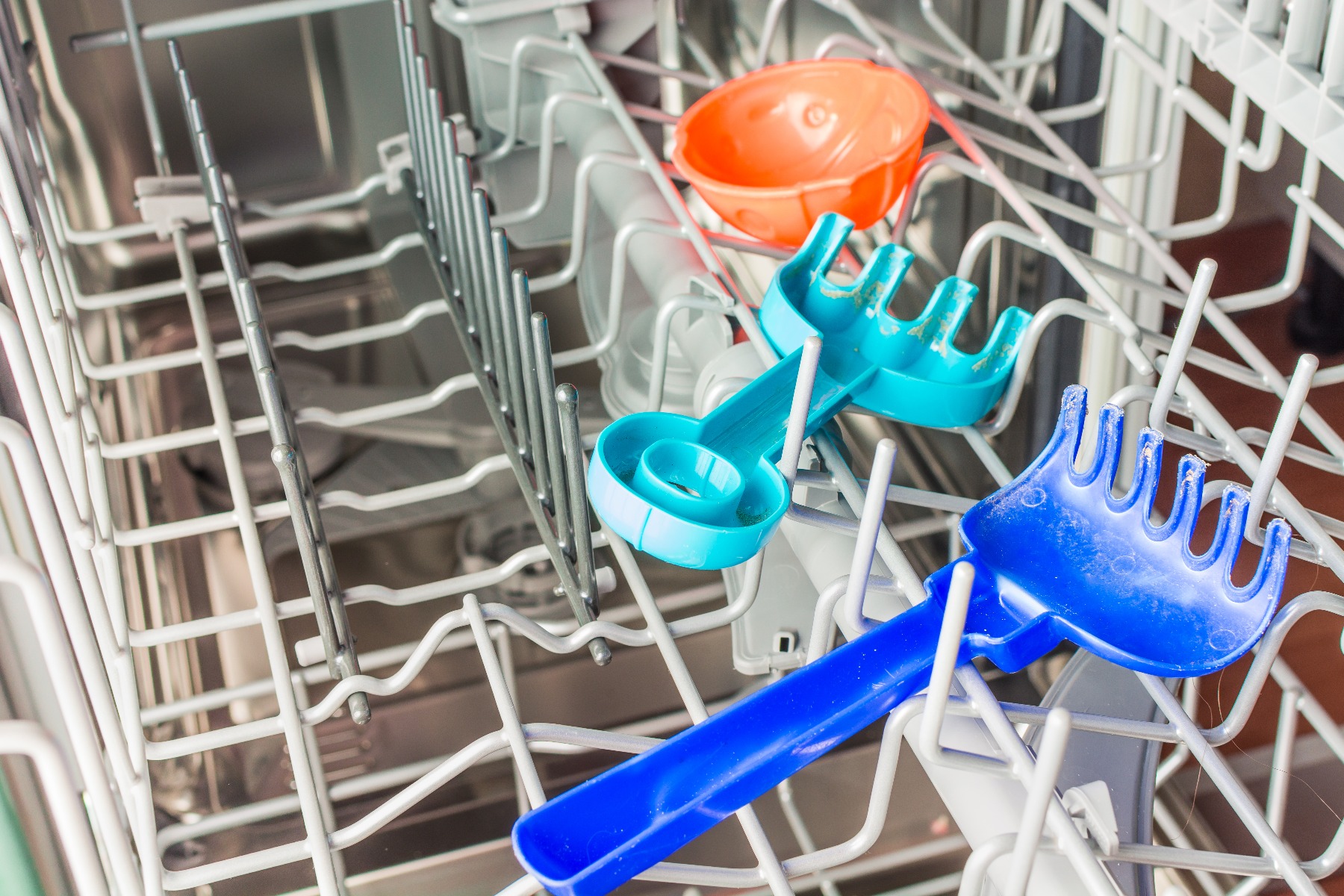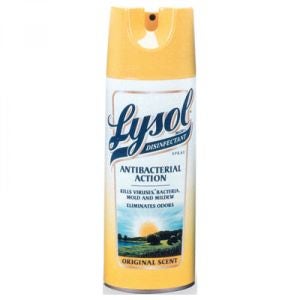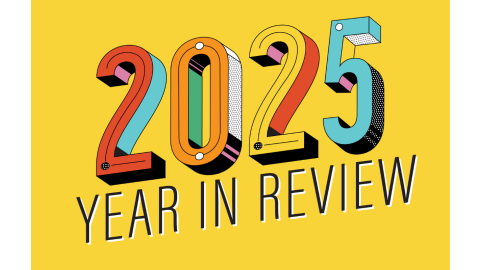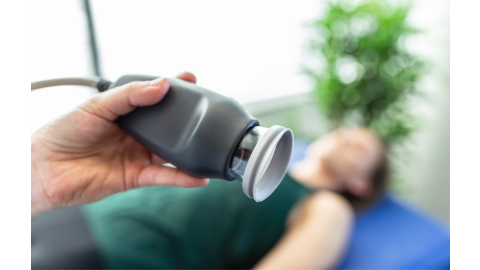At Daycare
Children in daycare are busy learning to share toys and hugs, but they also sneeze on plastic bricks and forget their play food is only pretend. This means lots of germs are spread from children’s hands and mouths to toys... and then other children. Preventing cold and flu germs from spreading isn’t always possible, but you can limit your risk by cleaning, disinfecting, and sanitizing toys, table tops, and other surfaces.

At Home
When you have a little one, it seems like everything goes in their mouth. And when they’re older, children bring home plenty of germs from school, playdates, and other activities. Learn how to clean, sanitize, and disinfect your child’s favorite toys from baby dolls to stuffed animals and why each step is necessary.

And it’s not just toys, learn how to clean, sanitize, and disinfect other surfaces your child touches to help prevent the spread of germs!
What is the difference between cleaning, sanitizing, and disinfecting?
- Cleaning: Remove dirt and stains
- Cleaning simply means washing with mild soap and water
- This removes dirt and some germs, but doesn’t kill bacteria or viruses
- Sanitizing: Kills 99.9% of germs and bacteria
- Reduces the number of germs on surfaces or objects by at least 99.9% to a level considered safe by public health standards, but doesn’t kill all germs
- It doesn’t necessarily clean surfaces and many surfaces must be clean before being sanitized
- Disinfecting: Kills 99.999% of pathogens and viruses listed on the product label
- Disinfecting uses chemicals to kill 99.999% of germs on hard, non-porous objects or surfaces
- Many surfaces should be cleaned before being disinfected

Dwell time (contact time): Make sure you read the dwell time on the sanitizer’s or disinfectant’s label, that’s the amount of time the sanitizer/disinfectant must be left visibly wet on the surface and in contact with the germs to kill them. Use a timer and reapply if needed to keep the surface wet until the dwell time is over.
Cleaning

You can clean some toys using your washing machine, such as dress up clothes and costumes. Many stuffed toys can also be washed, however, check their label to confirm. For a gentler washing, place the toy in a pillow case and tie it shut before putting it in the wash.
Some stuffed toys can be dried using a dryer on low or no heat, but some glued on parts can’t handle the high heat. Air dry if possible, placing the plush toy near a dehumidifier or fan to ensure the stuffing dries. To restore fluffiness, use a blow dryer on low heat or air only.

For other basic cleaning needs, use soap and water. For example, when wiping down tables after fingerpainting or when cleaning any visibly dirty toys. You can wipe down wooden toys with a soapy damp rag. You never want to soak wooden toys because it can warp the wood.

Before sanitizing or disinfecting toys, you’ll want to clean them with soap and water so that they can be sanitized and disinfected effectively.
Sanitizing

Ready to sanitize?
You can put many plastic toys in the dishwasher on the top from big building blocks and plastic trucks to sand toys. If the hard plastic toys are smaller, put them in a mesh bag. Be sure to check the toy’s instructions first and don’t put any toys with batteries, sound, or lights in the dishwasher. Run the dishwasher on a hot water or sanitizing cycle using dishwashing detergent. You can sanitize pacifiers at the same time (or boil your pacifiers for 1 minute).

While a dishwasher is convenient when sanitizing at home, it’s not as simple when you’re a teacher who needs to bring home kids’ toys or for those who have a lot of toys that need sanitizing. You might prefer to use a bleach solution for your plastic toys instead. Wipe down the plastic toys first. Then, soak them in a diluted bleach solution for 5 minutes following the directions on your bottle. Rinse the toys well with hot water and let them dry before allowing kids to play with them.
If you want to sanitize plush toys, use a mild detergent and laundry sanitizer. Either hang the toy to dry or use the dryer depending on the care instructions on the toy’s tag.
If the toy has lights or batteries, you don’t want to dunk it in water! You can wipe it down with the bleach and water mixture using a damp rag, let dry, and wipe again with a clean rag dipped in just water, and then dry.
Or you could use a sanitizing spray like the Clorox Anywhere Hard Surface Spray. It’s powerful enough to kill 99.9% of germs and gentle enough to use around kids. Ensure the toy is thoroughly wet and let stand for 2 minutes, then wipe it or let it air dry. There’s no need to rinse. You can also use this spray on countertops, doorknobs, and more! It’s great for wiping down desks and tables at the end of the school day too, even if they’re used for snack time.
Disinfecting

Time to disinfect!
For electronics, like a toy with batteries, remote, iPad screen, keyboard, or mouse use a Clorox Disinfecting Wipe. You can also use the wipes on plastic toys, changing tables, diaper pails, and more to keep your home clean. Or use on desks and tabletops at school to help prevent the spread of germs. After using a disinfecting wipe, wipe baby toys down with water and a clean cloth before handing them back to your child!
If you’re looking for another disinfecting option, check out Clorox Disinfecting Spray or Lysol Disinfecting Spray. Follow the directions on the label. Lysol states that you should thoroughly spray the hard surface so it stays wet for 3 minutes and then air dry and wash with clean water afterwards. You can also use the spray to sanitize soft, difficult to clean toys by spraying until the fabric is wet, but not saturated (it needs to remain wet for 30 seconds to sanitize and 10 minutes to disinfect).
f you’re looking for a 4-in-1 disinfectant, try the Clorox 4 in 1 Disinfectant and Sanitizer! It disinfects, reduces allergens, sanitizes the air, and sanitizers fabric with every spray. You can use it on fabric, mattresses, couches, and more!
Or choose Clorox Hydrogen Peroxide Disinfectant for use on counter tops, tables, diaper pails, and toilet areas. It can also be used to sanitize 100% cotton and 100% polyester soft surfaces, like mats for nap time, chairs, and couches. You’ll need to wear gloves when using this disinfectant.
How Often Should You Clean Toys

- At home, you should sanitize hard plastic toys and bath toys weekly if they are played with every day. You should also wipe down electronics once a week.
- Plush toys should be washed once every other week or once a week if your child sleeps with them or plays with them regularly.
- Baby toys should be cleaned the most frequently. If the toy goes in your baby’s mouth or is dropped on the floor, these toys should be cleaned every one to two days.
If you work in a daycare center or classroom, check out this cleaning frequency schedule from The National Association for the Education of Young Children (NAEYC). It covers everything from floors to tabletops, pacifiers to activity centers, and keyboards to cots.
Remember...

When choosing a product to clean, sanitize, or disinfect always read the label before use. And never mix bleach with any other chemical cleaning product!
If you are a daycare provider or teacher, your state child care licensing regulations may have rules on disinfecting solutions, water temperature, the use of dishwashers, and more. They differ by state, so be sure to check yours.
And while you’re cleaning your kid’s toys, don’t forget about all of the other surfaces that they touch!
Help keep your children healthy at home and at school by cleaning, sanitizing, and disinfecting, toys and other frequently touched surfaces!
References
- UCSF Institute for Health & Aging, UC Berkeley Center for Environmental Research and Children's Health, Informed Green Solutions, and California Department of Pesticide Regulation. (2013). Green Cleaning, Sanitizing, and Disinfecting: A Toolkit for Early Care and Education, University of California, San Francisco School of Nursing: San Francisco, California. Retrieved from https://bit.ly/3dUUgDv
- Lysol. (n.d.). The Complete Guide to Cleaning Your Baby's Toys. Lysol. Retrieved from https://bit.ly/35wwXMv
- Redmile, L. & Forte, C. (2020). How to Clean and Disinfect Toys, According to Cleaning Experts. Good Housekeeping. Retrieved from https://bit.ly/3m9k8hN
- https://bit.ly/3m9k8hN https://bit.ly/3m9k8hN
- Washington State Department of Health. (n.d.). Dangers of Mixing Bleach with Cleaners. Retrieved from https://bit.ly/3m9kyET
Medical Disclaimer: The information provided on this site, including text, graphics, images and other material, are for informational purposes only and are not intended to substitute for professional medical advice, diagnosis or treatment. Always seek the advice of your physician or other healthcare professional with any questions or concerns you may have regarding your condition.








 France
France Australia
Australia











